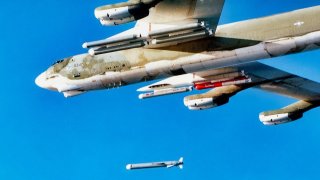The Air Force Freaked: A B-52 Bomber Hit a Tanker and Lost 4 Nuclear Bombs
The loss of the B-52 bomber airplane was only part of the problem; the B-52 had been carrying four B28F1 nuclear weapons. The U.S. Air Force clearly had a nightmare problem on its hands.
Summary and Key Points: A recent article by Dario Leone, based on historian Peter E. Davies' book "Chrome Dome 1960-68: The B-52’s High-Stakes Cold War Nuclear Operation," describes the collision of a B-52 Stratofortress with a KC-135 Stratotanker during Operation Chrome Dome.

-The 1966 incident occurred over Palomares, Spain, resulting in the loss of both aircraft and the contamination of the area with plutonium from four nuclear bombs.
-The collision happened during an aerial refueling exercise when the B-52 pilot misjudged the approach, causing a fatal overrun.
B-52 Collides with KC-135: The Story Behind the 1966 Palomares Nuclear Accident
Dario Leone with The Aviation Geek Club has a new article explaining how a B-52 Stratofortress collided with a KC-135 Stratotanker. Leone’s article is based on excerpts of historian Peter E. Davies’ book, Chrome Dome 1960-68: The B-52’s High-Stakes Cold War Nuclear Operation.
Davies’s book describes Operation Chrome Dome, during which twelve B-52s were required to maintain a constant airborne alert, always within striking distance of the Soviet Union. The B-52s stationed in a static orbit in two locations: over the Mediterranean, and just north of Alaska. They stayed aloft for 24 hours at a time, each B-52 flying for a distance of 10,000 miles before another one relieved it.
“In each cockpit a top-secret Combat Mission Folder contained details of the routes and procedures for a nuclear attack on a pre-determined Soviet target,” Leone wrote.
The Chrome Dome missions were controversial, of course – especially in light of several B-52 mishaps (including the loss of nuclear weapons). The most famous mishap occurred off the coast of Spain, in what is known as the Palomares Broken Arrow accident.
Broken Arrow
In January 1966, one of the four Chrome Dome B-52s took off from Seymour Johnson Air Force Base, North Carolina, at dawn. The B-52 reached “the furthest extent of the mission around the Soviet-Turkish border after refueling over the Golden Spur Air Refueling Area, Spain by a tanker from Torrejon Troubadour 11 and 13,” Leone writes. “On the return flight along the southern route [the B-52] refueled over the Almeria coast from [a KC-135].”
Aerial refueling was very safe. At the time of the 1966 Chrome Dome mission, about three-quarter of a million aerial refuelings had been completed successfully, with only one mishap – a collision in October 1959 over the skies of Kentucky. Meanwhile, Chrome Dome-related aerial refuelings happened as much as once every six minutes, without incident. So, what happened next was statistically unusual and surprising to those involved.
After closing at a higher speed than planned, the B-52 collided with the KC-135 while refueling, at 30,500 feet, two miles inland from the coast of Spain, over the village of Palomares.
What Happened? The B-52 and Downed Nuclear Bombs
“The accident report concluded that the staff relief pilot, World War II B-17 bomber veteran Maj Larry G. Messinger, was being given some in-flight refueling practice under the supervision of the aircraft commander, Capt Charles Wendorf,” Leone reported. “Messinger closed in on the tanker at 260kts, but then increased speed 900ft from the tanker.”
The KC-135 warned Messinger that the B-52 was on track for an overrun. Reactively, Messinger deployed the B-52’s airbrakes before Wendorf could intervene, causing the B-52 to pitch upward, where it struck the underside of the KC-135’s fuselage.
The KC-135’s 33-foot-long refueling probe penetrated the B-52’s upper fuselage/wing joint, “causing an explosion and fatal damage to a longeron (spine)…separating the left wing,” Leone writes. “Disintegration followed quickly, with the forward fuselage falling away.”

Where Did the Nuclear Weapons Go?
The loss of the airplane was only part of the problem; the B-52 had been carrying four B28F1 nuclear weapons. “One landed near the beach, a second impacted a cemetery, and another buried itself in a tomato field. The 100ft wide retarding parachute on the fourth opened and it drifted out to sea,” Leone writes. The ensuing search for the weapons was an ordeal, of course. Two of the bombs “went through the preliminary high-explosive stage of detonation” while nuclear debris contaminated about 1,400 tons of soil and vegetation with plutonium.
About the Author: Harrison Kass
Harrison Kass is a defense and national security writer with over 1,000 total pieces on issues involving global affairs. An attorney, pilot, guitarist, and minor pro hockey player, Harrison joined the US Air Force as a Pilot Trainee but was medically discharged. Harrison holds a BA from Lake Forest College, a JD from the University of Oregon, and an MA from New York University. Harrison listens to Dokken.
All images are Creative Commons or Shutterstock.
From the Vault
Russia Freaked Out: Why the U.S. Navy 'Unretired' the Iowa-Class Battleships
Battleship vs. Battlecruiser: Iowa-Class vs. Russia's Kirov-Class (Who Wins?)


